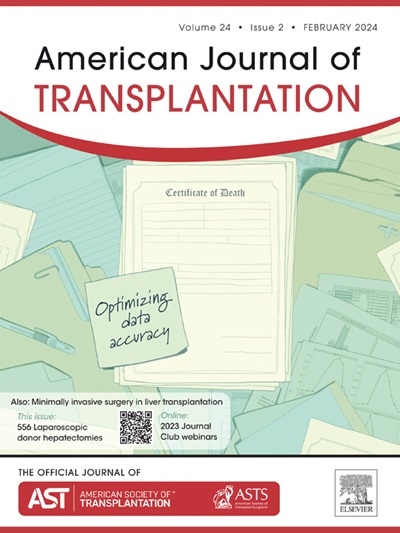Islet cell alloautotransplantation 12 years after simultaneous pancreas-kidney transplantation
IF 8.2
2区 医学
Q1 SURGERY
引用次数: 0
Abstract
Late enteric bleeding in the setting of simultaneous pancreas-kidney transplantation is an uncommon but perhaps underrecognized complication that can result in major morbidity. There are significant challenges both in the diagnosis and management of this complication, and in certain circumstances, graft pancreatectomy of an otherwise functioning graft may be required. Here we present the case of a 49-year-old simultaneous pancreas-kidney transplant recipient who presented 12 years after transplant with recurrent life-threatening enteric bleeding that required a graft pancreatectomy. After pancreatectomy, islets were isolated from the allograft—190 000 islet equivalents with 90% viability and 27% purity. The islets were transplanted back into the recipient percutaneously via the portal vein, with detectable C-peptide 6 weeks after procedure and no hypoglycemic unawareness. A second allogeneic islet cell transplant was subsequently performed two months later, with the patient’s latest C-peptide of 430 pmol/L, having maintained good renal function. Alloautotransplantation is a potential treatment option for patients that require graft pancreatectomy and has the advantage of preserving some beta-cell function while not necessitating additional immunosuppression.
胰岛细胞移植:SPK移植后12年。
在胰肾联合移植(SPK)的背景下,晚期肠性出血是一种不常见的,但可能未被认识到的并发症,可导致主要的发病率。在这种并发症的诊断和治疗方面都存在重大挑战,在某些情况下,可能需要对功能正常的移植物进行胰腺切除术。在这里,我们提出一个49岁的SPK受者,他在移植后12年出现复发性危及生命的肠出血,需要移植胰切除术。胰岛切除术后,从同种异体移植物中分离出胰岛- 190,000胰岛当量(IEQ),存活率为90%,纯度为27%。胰岛经门静脉经皮移植回受体,术后6周可检测到c肽,无低血糖意识。两个月后进行第二次异体胰岛细胞移植,患者最新c肽为430 pmol/L,肾功能保持良好。同种异体自体移植是需要移植物胰腺切除术的患者的潜在治疗选择,其优点是保留一些β细胞功能,而不需要额外的免疫抑制。
本文章由计算机程序翻译,如有差异,请以英文原文为准。
求助全文
约1分钟内获得全文
求助全文
来源期刊
CiteScore
18.70
自引率
4.50%
发文量
346
审稿时长
26 days
期刊介绍:
The American Journal of Transplantation is a leading journal in the field of transplantation. It serves as a forum for debate and reassessment, an agent of change, and a major platform for promoting understanding, improving results, and advancing science. Published monthly, it provides an essential resource for researchers and clinicians worldwide.
The journal publishes original articles, case reports, invited reviews, letters to the editor, critical reviews, news features, consensus documents, and guidelines over 12 issues a year. It covers all major subject areas in transplantation, including thoracic (heart, lung), abdominal (kidney, liver, pancreas, islets), tissue and stem cell transplantation, organ and tissue donation and preservation, tissue injury, repair, inflammation, and aging, histocompatibility, drugs and pharmacology, graft survival, and prevention of graft dysfunction and failure. It also explores ethical and social issues in the field.

 求助内容:
求助内容: 应助结果提醒方式:
应助结果提醒方式:


